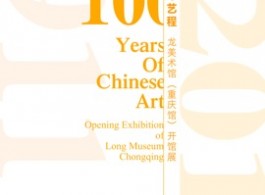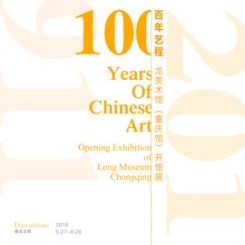Curator: Wang Wei
Dates: May 27, 2016 — Aug 28, 2016
Address: Long Museum (Chongqing), No.29, Jinsha Road, No.9 Juxianyan Plaza, Jiangbei District, Chongqing
China had undergone enormous changes from 1911 to 2011, which is also a hundred years of both struggles and transcendences for the Chinese art. As Hermann Bahr, a German aesthetician, said, the history of painting is nothing but the history of vision- or seeing. A man views the world according to his attitude towards it. Hence the history of painting overlaps that of philosophy, or even the unwritten history of philosophy.100 years of art journey since 1911 has created not only diverse art movements and styles, but also the cultural ecology together with the social development. In this sense, the art history started from 1911 to 2011 is a history of vision, society and philosophy.
100 Years of Chinese Art (1911-2011), featuring more than one hundred iconic works through 1911 to 2011 from the collection, celebrates the grand opening of Long Museum Chongqing. Through their unique historical value, cultural impact and epoch connotation, these works reflect the practice and exploration by Chinese artists during one hundred years. And they are going to witness the vigor and vitality of the Chinese art in the future. The exhibition is divided into five parts: The Introduction of Western Studies to the East, Psalm of Art, Cultural Revolutionary Art, A New Era and Ensemble.
Part One: The Introduction of Western Studies to the East
After the Xinhai Revolution (Revolution of 1911), a large numbers of progressive youths regarded rejuvenating the nation and rescuing national culture as their own responsibilities, and traveled far to Europe, America and Japan to study art. These young people came back to China after completing their studies, and established or taught in arts academies. They trained students, promoted art theories, and led Chinese painting’s transformation from tradition to modernity. These Chinese youths were among the earliest group who had studied in Europe, America and Japan, becoming pioneers in bringing Western oil paintings in China art culture, and contributed to a prosperous landscape of art. During that period many diversified schools and flow of ideas contend, including Realism, Impressionism and Expressionism. Although all artists’ point of views differs greatly with each other, they all shined in the 20th century with their own art practices, thoughts, concepts and individual styles.
However, the benign art structure and education that gradually came into shape were crushed by the gunfire in 1937. The National Government moved to Western China, making a group of artists traveled in Guizhou, Sichuan, Gansu and Qinghai Provinces to seek new space for art creation. More artists faced up to the reality, and used painting brush and color to wake people up. The goal of art creation was no longer satisfying personal appetite, and artists jumped out of the confinement of individuality in confront of the gory reality. Art came to the front line as a propaganda tool for the Anti-Japanese War. Woodcut printing, stone carving and illustration, which were over all the other forms, became the main and most effective propaganda art forms at that time.
Part Two: Psalm of Art
After the establishment of People’s Republic of China in 1949, the focus of national development shifted to socialist construction, and thematic creation of revolutionary history continued. Artists were highly inspired by great achievements of People’s Republic of China, Therefore, the creation theme gradually changed to the praising social life, including figures, events, social transformation and construction achievements. In 1942’s Talks at the Yan’an Forum on Literature and Art, Mao Zedong called for artists’ further probe into the countryside, military troupes, factories and other grass-root units. Art was then led to depict people’s life, and eulogize the realistic society, the bright future, and the spiritual happiness and richness of people.
Compared to the dominant Realism paintings, and under the art and literature guidance of “Different Schools Contending with One Another”, the early pioneers, who had studied in Europe, America and Japan, silently began their exploration on art styles and roads against all the odds.
Part Three: Cultural Revolutionary Art
The decade of Cultural Revolution between 1966 to 1976 was a devastating hit to China, and created the fine art images that differs from other periods , which had to be “red, bright, and shining” (hong, guang, liang) and “lofty, glorious, and complete”(gao, da, quan) . The first feature of Cultural Revolutionary Art is that it praises and eulogizes great Chairman Mao, whose grand figure is highlighted against the surrounding crowd in factories, countryside and various other public places. The second feature is that it is a psalm of heroism, and proletariat heroes stand out to meet the need of political reality. As a product of a particular time, pictures and paintings of Cultural Revolutionary Art have become a precious literature for the study of this historical period.
Cultural Revolution had done a lot of damages to Chinese art, and had an adverse impact on the individualistic creation of artists. The struggling pioneers bore cruel oppressions, many were deprived of the right of creation, and their artworks were burned. Despite all these, these artists still relentlessly pursued their ideal art, and consistently explored and experimented modern and contemporary art.
Part Four: A New Era
At the end of 1970s, China entered a new period of historical transition. Old generation oil painters picked up their brushes again, and glowed vigorously in art creation with joy and passion. The ideological line of “emancipating the mind and seeking truth from facts” had removed people’s bondage and fetters, and aroused their subjective consciousness and activated their creativity. The revival of ideological exploration and humanity, and reflections and charges on Cultural Revolution and the pursuit of real life all came back to the field of art like a fresh breeze. When deciding what to express and how to express, artists boldly searched their own language at will. Art of Scars, Neo-classical Art and Stars Art Exhibition and 1985 Art Trend constituted the main art landscape of the 1980s. The art creation of this period reached unprecedented prosperity, and the exploration of different art forms, along with the purification and regression to art language, ushered in the prelude of a new era.
Part Five: Ensemble
In the 1990s, along with the advancement of market-oriented reforms, instead of big art movements, Chinese contemporary art begins to develop diversely with more social context. From Political Pop to Cynical Realism, from New Generation to New Expressionism from Post-1989 to Post-Sense Sensibility, Chinese artists investigate into private concerns and public culture. Influenced by western modern and contemporary art, Chinese artists start applying new concepts, such as symbolic elements and inspirations from everyday life to create unique works, which focus more on specific questions than the conceptual ones and keep shaping the relationships between art and reality. In the meantime, in the background of globalization and consumerism, Chinese contemporary art has been facing the international challenges and opportunities it had never encountered before.


